TV REVIEWS : ‘Drug War’ Waste Seen in Brutal Proportions
- Share via
Government boondoggle hounds should be on alert tonight, as “Frontline” fires a punishing broadside at the U.S. Customs Service and the Drug Enforcement Agency in “What Happened to the Drug War?” (at 9 tonight, KCET Channel 28 and KPBS Channel 15; 8 p.m., KVCR Channel 24; 9 p.m. Wednesday, KOCE Channel 50). The cases compiled by producers-reporters Jim Gilmore and Joe Rosenbloom of alleged and real corruption, technological snafus, agency non-coordination and pure, unmitigated waste pile up like a very bad dream.
Except that this is a very real example of why citizens’ faith in government is at such a low ebb. With a great rhetorical flourish in the 1980s, the Ronald Reagan and George Bush administrations’ vaunted war on drugs became a kind of new national defense plan, with most funds devoted to border interdiction and the destruction of coca production--the source of cocaine--in South America.
Gilmore and Rosenbloom find that, despite the involvement of 18 U.S. agencies, the purchase of such new high-tech border surveillance equipment as the $18-million apiece Aerostat radar balloons and the $2 billion in annual spending on border interdiction, the hemorrhaging of the Texas-to-California border continues.
The reporters ride at one point with a DEA informant and former drug smuggler, who shows how to fly a small plane low enough to beat the vast and expensive radar net the United States has laid across the entire southern lip of the country. The Aerostat balloon meant to track the area of the pilot’s flight was where it too often seems to be: grounded, for repairs.
The sea and land wings of the drug war appear to be doing no better. Marines assigned to monitor border activity echo the frustration expressed by former agents assigned to high-speed surveillance boats. There is a lot of waiting and watching but extremely little capturing of drugs.
Carol Hallett, Customs Service director under Bush, reads this inactivity as success, that deterrence is working. But the report’s detailed account of the vast Tapias family smuggling ring, which routinely shipped tons of cocaine through heavily monitored border stations, shows Hallett to be terribly mistaken. At the same time, the border patrol is dogged with allegations of bribery and corruption.
The profit incentive seems to allow the drug trade to withstand the dragnet thrown up around it by the government, and the question Gilmore and Rosenbloom leaves us with is whether the Clinton Administration and the new Congress will continue throwing good money after bad.
More to Read
Sign up for Essential California
The most important California stories and recommendations in your inbox every morning.
You may occasionally receive promotional content from the Los Angeles Times.










